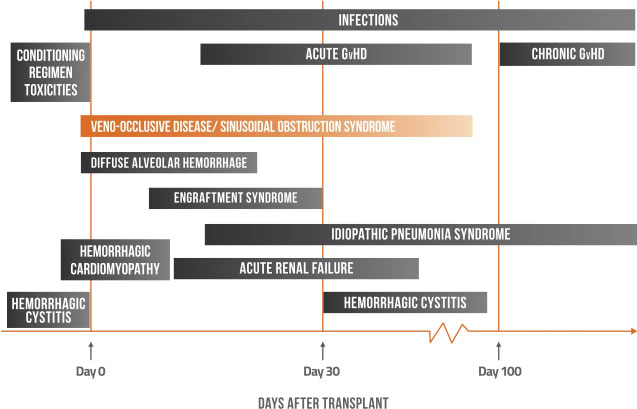GvHD=graft-vs-host disease; HSCT=hematopoietic stem-cell transplantation; SOS=sinusoidal obstruction syndrome; VOD=veno-occlusive disease.
References: 1. Saria MG, Gosselin-Acomb TK. Hematopoietic stem cell transplantation: implications for critical care nurses. Clin J Oncol Nurs. 2007;11(1):53-63. 2. Coppell JA, Richardson PG, Soiffer R, et al. Hepatic veno-occlusive disease following stem cell transplantation: incidence, clinical course, and outcome. Biol Blood Marrow Transplant. 2010;16(2):157-168. 3. Gratwohl A, Hermans J, Apperley J, et al; Working Party Chronic Leukemia of the European Group for Blood and Marrow Transplantation. Acute graft-versus-host disease: grade and outcome in patients with chronic myelogenous leukemia. Blood. 1995;86(2):813-818. 4. Schuster MG, Cleveland AA, Dubberke ER, et al. Infections in hematopoietic cell transplant recipients: results from the organ transplant infection project, a multicenter, prospective, cohort study. Open Forum Infect Dis. 2017;4(2):1-7. 5. Panoskaltsis-Mortari A, Griese M, Madtes DK, et al; American Thoracic Society Committee on Idiopathic Pneumonia Syndrome. An official American Thoracic Society research statement: noninfectious lung injury after hematopoietic stem cell transplantation: idiopathic pneumonia syndrome. Am J Respir Crit Care Med. 2011;183(9):1262-1279. 6. Chang L, Frame D, Braun T, et al. Engraftment syndrome after allogeneic hematopoietic cell transplantation predicts poor outcomes. Biol Blood Marrow Transplant. 2014;20(9):1407-1417. 7. Afessa B, Tefferi A, Litzow MR, et al. Diffuse alveolar hemorrhage in hematopoietic stem cell transplant recipients. Am J Respir Crit Care Med. 2002;166(5):641-5. 8. Fan K, McArthur J, Morrison RR, Ghafoor S. Diffuse alveolar hemorrhage after pediatric hematopoietic stem cell transplantation. Front Oncol. 2020;10:1757. 9. Carreras E. Early complications after HSCT. In: Apperley J, Carreras E, Gluckman E, et al, eds. The EBMT Handbook. 6th ed. Paris, France: European School of Haematology; 2012:176-195. 10. Corbacioglu S, Carreras E, Ansari M, et al. Diagnosis and severity criteria for sinusoidal obstruction syndrome/veno-occlusive disease in pediatric patients: a new classification from the European Society for Blood and Marrow Transplantation. Bone Marrow Transplant. 2018;53(2):138-145. 11. Eisenberg S. Hepatic sinusoidal obstruction syndrome in patients undergoing hematopoietic stem cell transplant. Oncol Nurs Forum. 2008;35(3):385-397. 12. Tuncer HH, Rana N, Milani C, et al. Gastrointestinal and hepatic complications of hematopoietic stem cell transplantation. World J Gastroenterol. 2012;18(16):1851-1860. 13. Murakami J, Shimizu Y. Hepatic manifestations in hematological disorders. Int J Hepatol. 2013;2013:484903. 14. Carreras E. How I manage sinusoidal obstruction syndrome after haematopoietic cell transplantation. Br J Haematol. 2015;168(4):481-491. 15. Mohty M, Malard F, Abecassis M, et al. Revised diagnosis and severity criteria for sinusoidal obstruction syndrome/veno-occlusive disease in adult patients: a new classification from the European Society for Blood and Marrow Transplantation. Bone Marrow Transplant. 2016;51(7):906-912. 16. Bajwa RPS, Mahadeo KM, Taragin BH, et al. Consensus report by Pediatric Acute Lung Injury and Sepsis Investigators and Pediatric Blood and Marrow Transplantation Consortium Joint Working Committees: supportive care guidelines for management of veno-occlusive disease in children and adolescents, part 1: focus on investigations, prophylaxis, and specific treatment. Biol Blood Marrow Transplant. 2017;23(11):1817-1825. 17. Reddivalla N, Robinson AL, Reid KJ, et al. Using liver elastography to diagnose sinusoidal obstruction syndrome in pediatric patients undergoing hematopoietic stem cell transplant. Bone Marrow Transplant. 2020;55(3):523-530.
